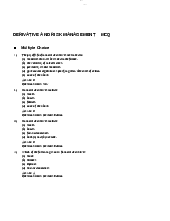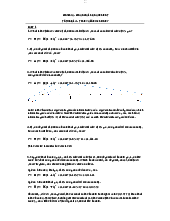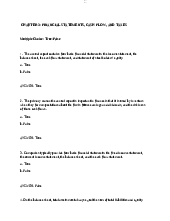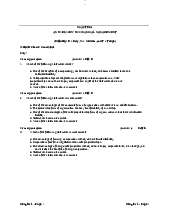



















Preview text:
lOMoARcPSD|44744371 lOMoARcPSD|44744371 HANOI UNIVERSITY
FACULTY OF MANAGEMENT AND TOURISM FINANCIAL MANAGEMENT
ANALYSIS OF THE PERFORMANCE AND VALUATION
OF THE VIETNAM DAIRY PRODUCTS JOINT STOCK COMPANY
Tutor: Ms Nguyen Thi Van Anh Tutorial: Tut 2 Group: Nguyễn Hà Linh ID: 1904040066
Nguyễn Thị Bích ID: 1904040014 Chu Thị Thùy Dung ID: 1904040021 Trần Quế Anh ID: 1804000009 Lê Hoàng Long ID: 1804000060 Content pages: Date: 07 May 2021. lOMoARcPSD|44744371
Executive summary
This report is presented for the purpose of analyzing and evaluating the performance
of Vietnam Dairy Products Joint Stock Company (VNM). To achieve this purpose,
we have conducted research on company fundamentals and its relationship with
financial markets, finding strengths and weaknesses on the basis of newspaper
analysis. financial statements. Then, predictions about the future and direction of the
company, which are outlined in the recommendations below. Besides, the company's
activities are also explored in detail. Finally, the report concludes with company
valuations and useful recommendations for investors and financial managers. In
general, by analyzing the data, it turns out that the shares of both companies are
overvalued, so stakeholders should sell the shares. i lOMoARcPSD|44744371 TABLE OF CONTENTS
Executive summary.....................................................................................................................i
I. Introduction...........................................................................................................................1
II. Evaluation of the performance and value of the company........................................................2
1. Analysis of financial statement............................................................................................2
1.1. Financial ratio calculation........................................................................................................................2
1.2. Ratio trend analysis....................................................................................................................................3
a. Liquidity..........................................................................................................................................................3
b. Assets management......................................................................................................................................5
c. Debt management.........................................................................................................................................7
d. Profitability.....................................................................................................................................................8
e. Market value................................................................................................................................................11
1.3. Dupont calculation and performance.................................................................................................12
1.4. Strengths and weaknesses of Vinamilk.............................................................................................14
1.4.1. Strengths................................................................................................................................................14
1.4.2. Weaknesses...........................................................................................................................................14
1.4.3. Recommendation................................................................................................................................15
2. Valuation.......................................................................................................................................................15
2.1. Free cash flow and the growth rate of free cash flow........................................................17
2.2. Weighted Average Cost of Capital and value of the firm..................................................17
2.3. Recommendation...............................................................................................................17
III. Conclusion.........................................................................................................................18
REFERENCES........................................................................................................................19 ii lOMoARcPSD|44744371
APPENDICES.........................................................................................................................21
APPENDIX A: Calculation for industry average ratio..............................................................21
APPENDIX B: Calculation of DuPont Equation.......................................................................22
APPENDIX C: Calculations for the firm’s valuation section..............................................23 iii lOMoARcPSD|44744371 I. Introduction
Due to the breakout of Covid19, the entire economy in the whole world to go down, but in
Vietnam, the dairy industry even develops and is not significantly affected. Experts in the dairy
industry said that in the future, the dairy industry is still considered a potential because the
consumption of milk per capita in Vietnam is still low. According to Vietnam Feed Association –
VFA research, demand for raw fresh milk increased by about 61%, from 500 million liters
(2010) to 805 million liters (2015). As a populous country with a high population growth rate of
1.2% per year, the dairy market in Vietnam has great potential. The GDP growth rate of 6-8% /
year, per capita income increasing 14.2% / year, combined with the trend of improving the health
and stature of the Vietnamese people makes the demand for products. Milk always keeps a high
growth rate. In 2010, on average, each Vietnamese consumed about 15 liters of milk/year. It is
forecasted that by 2020, this figure will nearly double to 28 liters of milk/year/person. During the
development of the dairy industry in recent years, many corporations and companies have
jumped in and out, some of them have had considerable successes such as TH True Milk, Dutch
Lady, Nestle, NutiFood, and so on. However, the corporation is focused on this project, which
was honored in the top 200 of best revenue listed companies of over 1 billion the Asia Pacific in
2019 (Forbes Asia), is Vietnam Dairy Products Joint Stock Company (VNM). Developing for at
least 40 years, Vinamilk increasingly asserted its position in the market. Their price of shares and
financial reports have been published in the official exchange market.
Generally, Vietnam Dairy Products Joint Stock Company (VNM) is consistently determined to
be a grade brand in the food and beverage industry with a large number of domestic and
international customers who are served a variety of nutrient and health products. Established on
August 20, 1976, VNM is a well–known corporation focusing on milk, probiotics, yogurt, ice
cream, soft drinks, coffee, and other products derived from milk. Vinamilk has a system of
factories not only in domestic but also in international nations. Spreading from Thanh Hoa, Nghe
an, Da Nang, Tuyen Quang, Ha Tinh, Lam Dong to Myanmar, Thai Lan, New Zealand, and 20
other countries, Vinamilk is increasingly becoming a solid brand name in the market. Moreover,
VNM was awarded many noble medals by the Government and besides, this corporation also
expands to invest in activities such as the inauguration of the dairy farm, construction of many
new technologies, installed advanced equipment and modern machines in all of its factories. 1 lOMoARcPSD|44744371
To achieve today's successes, the mentorship of Boards of Directors and the Chief executive
officer is indispensable. Chairwoman of Vinamilk currently is Le Thi Bang Tam with 6 years in
this position, with 9 other members: Mai Kieu Lien, Michael Chye Hin Fah, Lee Meng Tat, Le
Thanh Liem, Do Le Hung, Dang Thi Thu Ha, Alain Xavier Cany, Nguyen Thi Tham, Nguyen Ba
Duong, and Michael Chye Hin Fah since 2015. Ms. Tam and Ms. Lien are insiders while the
others are outsiders, and Ms.Lien has had the most number of shares, 0.26% when the others
have had the number of shares smaller than 0.05%. The rest of the capital contribution belongs to
the State and other businesses: State Capital Investment Corporation (SCIC) was found to be
36%, whereas F&N Dairy Investments Pte Ltd accounted for 17.69%. II.
Evaluation of the performance and value of the company
1. Analysis of financial statement
1.1.Financial ratio calculation Industr VNM y Ratio Avera Comm Ratio Formula g Averag e e (5 e (5 nt 2016 2017 2018 2019 years) years) 2020 Liquidity Current 2.89x 1.99x 1.93x 1.71x 2.03x 2.09x 2.20x Poor Quick 2.19x 1.6x 1.41x 1.37x 1.74x 1.74x 2.03x Poor Asset Management Inventory 10.37x 12.7x 9.48x 11.27x 12.13x 6.47x 6.43x Good turnover Days sales outstanding 23 33 33 29 32 30 24 Poor (DSO) Fixed assets 5.64x 4.81x 3.92x 3.77x 4.3x 4.49x 5.57x Poor turnover Total assets 1.59x 1.47x 1.40x 1.25x 1.23x 1.28x 1.27x Good turnover Debt Management Total debt to Good 24% 31% 30% 33% 31% 30% 33% (Low total assets risk) 2 lOMoARcPSD|44744371 Times interest Very
240.01 415.32 231.21 117.59 94.14 219.65 410.49 earned (TIE) good Profitability Operating 23.80 23.95 22.68 22.78 22.75 23.13% 20.94% Good profit margin % % % % % Profit margin 20.01 20.14 19.42 18.74 18.84 19.39% 17.54% Good % % % % % Return on total 31.87 29.65 27.31 23.61 23.20 28.05% 22.47% Good assets (ROA) % % % % % Basic earning 37.99 35.27 31.78 28.63 27.96 Very power (BEP) % % % % % 32.33% 29.19% good Return on common equity 41.79 43.05 38.85 35.50 33.39 37.15% 28.88% Good (ROE) % % % % % Market Value Price/earnings
17.21x 29.41x 18.04x 19.17x 17.8x 20.33x 22.16x Poor (P/E) Market/book
0.0049 0.0079 0.0061 0.0054 0.001 0.0051 0.0044 Good (M/B)
1.2.Ratio trend analysis
From 2016 to 2020, Vinamilk had witnessed some positive changes that affected the operation.
In this part, we will use trend analysis and comparative analysis over the ratios calculated in the
previous part and access the effectiveness of the business. a. Liquidity: *Current: 3 lOMoARcPSD|44744371
The current ratio is a liquidity ratio that measures a company's ability to pay short-term
obligations or those due within one year. It can be clearly seen that from the year 2016-2019, the
current ratio for VNM was decreasing by 1.35. At the same time, the company had a lower
current ratio compared to the industry average, this fact makes us question whether the
management was using its assets efficiently since this number represents a higher risk of distress
for the investors and the lower probability to satisfy its current debt and other payables. *Quick:
The quick ratio measures the dollar amount of liquid assets available against the dollar amount of
current liabilities of a company. We can understand that a company that has a quick ratio higher
than 1 can instantly get rid of its current liabilities. For instance, a quick ratio of 1.74 of VNM in
2020 indicates that the company has $1.74 of liquid assets available to cover each $1 of its
current liabilities. Though compared to the average of the industry which equals 2.03 calculated
in the previous part, it seems like the company had not operated as productively as other firms in the dairy industry. 4 lOMoARcPSD|44744371 b. Assets management: *Inventory turnover:
Inventory turnover measures how fast the company sells its inventory. By the end of 2020, the
average inventory turnover ratio of Vinamilk was 6.47 which is slightly higher than the industry
average - 6.43. This number implies that the company had strong sales which was illustrated by
an image of a balanced scale between having enough in-stock product and not having to reorder too frequently.
*Days sales outstanding:
DSO is measured to show how many sales a company has made over a specific period of time. It
suggests how efficient the company's collection department is and the extent to which the company is
maintaining customer satisfaction. VNM's DSO is easily seen to be above the average of its 5 lOMoARcPSD|44744371
peers, which means it takes a long time for the company to recover money after sales. However,
for business operations, it is most beneficial for the company to recover outstanding debts as
quickly as possible. So, it can be observed that there appears to be a good operational management system. *Fixed assets turnover:
The fixed asset ratio is used as a component to deplete depreciation. A higher fixed asset
turnover ratio indicates that a company has effectively used investments in fixed assets to
generate sales. Compared to the peer average, VNM had slightly lower from 2016 to 2019 but
then rose again to reach near the average peer in 2020. *Total assets turnover: 6 lOMoARcPSD|44744371
The asset turnover ratio can be measured by a metric that can show the investor how efficiently
which company uses its assets to produce revenue compared to other firms in the same industry.
Despite the decline in the four-year period, we found that Vinamilk still tries to maintain the
average ratio above the industry which is 1.27. c. Debt management:
*Total debt to total assets:
Total debt to total asset is a ratio used to visualize how financially stable a company is. Despite
the fact this ratio of VNM has been increasing from 2016 but the company still manages to keep
it under the peer average. So, we can conclude that investing in Vinamilk is not as risky as in other firms. *Times interest earned: 7 lOMoARcPSD|44744371
Interest accrued is used to show a firm's ability to meet its debt obligations based on its present
income. By dividing EBIT by the total cost of the loan, we can be sure that the company can
afford to pay off its debts and it is worthwhile for investors to continue pouring money into the
business. Despite a given down-slope graph, we can see that the company is effectively
managing its operations for sustained growth. d. Profitability:
*Operating profit margin:
By dividing operating income over total revenue, this metric expresses how the company
generates its profit on a per-sale basis after considering variable costs except any interest or taxes
(EBIT). In the VNM case, the operating profit margin had slightly fallen off from 2016 to 2020
by 1.05. Though, using the average in the dairy industry in 2020 (20.94%), Vinamilk can still be
considered as a strong firm in maximizing its operations and reap profit. 8 lOMoARcPSD|44744371 *Profit margin:
By calculating the profit margin, we can compute the percentage figure that indicates how many
cents of profit the business has generated for each dollar of sale. In Vinamilk’s case in 2020, the
business announced that it had a 19% profit margin (higher than industry average - 17.54%)
during the last quarter and it means that it had a net income of $0.19 for each dollar of sales
generated. And since a higher operating margin is preferred meaning lower accounting costs,
Vinamilk seems to manage the business efficiently. *Return on assets:
This ratio indicates the effectiveness of using assets to generate revenues. Since it is computed
by net income over total assets, generally, the higher rate of return, the more effective the firm
converts the money it invests into net income. Even though there was a small decline over the
five-year period, compared to the average ROA of the industry, which is 0.27, according to 9 lOMoARcPSD|44744371
Investing.com report in 2020, Vinamilk’s ROA can still be considered as high rate and earned more money on less investment. *Basic earning power:
As it is relatively close to Operating Income, BEP formula includes non-operating income (such as
dividends paid on the stock a company holds) so the metric can show a wider view and more
accurate comparison between the firms in the same industry. So, for investors, they tend to look at
BEP over Operating Income while comparing the companies. Despite the lower extraction from
the asset to generate profit over the time, Vinamilk’s BEP can be considered as a potential
investment since its BEP is 3.14% higher than its peers’ average which is 29.19%. *Return on equity: 10 lOMoARcPSD|44744371
ROE is used to measure the profitability of a corporation in relation to stockholders’ equity. By
using the result calculated by dividing net income by shareholders' equity. The best practice to use
ROE is to compare the number with the industry average which is 28.88% and it can be clearly seen
that VNM’s ROE is higher than the industry averages up to 8.27%. A normal ROE could be 10% or
less than the industry average so the disparity between these ratios is acceptable. e. Market value: *Price/ Earnings
By using price earnings ratios (P/E ratio), we can measure how many times the earnings per
share (EPS) have been covered by the current market price of an ordinary share. It is computed
by dividing the current market price of an ordinary share by earnings per share. Through figure
3, we can conclude that VNM is a potential company since a company with a high P/E ratio are
often considered to be growth stocks. Though in the late 2019, we witnessed a fall in P/E which
can be explained by the existence of the Covid-19 Pandemic. 11 lOMoARcPSD|44744371 *Market/ Book
In the four-year from 2016 to 2020, there had been a massive fluctuation in the dairy industry.
We understand that a book-to-market ratio below 1 means that investors are willing to pay more
for a company than its net assets are worth. The company’s manager can see this as a good
sign since this could show that the company has healthy future profit projections and investors
are expected to pay for that future possibility.
1.3.Dupont calculation and performance
Specifically, we have the Dupont equation, which shown the return on equity rate can be estimated
through the profit margin, total asset turnover, and the equity multiplier. Moreover, it also presents the
relationships between asset management, debt management, and profitability ratios. =
(Return on Assets x Equity Multiplier) ×
(Profit Margin x Total Assets Turnover x Equity Multiplier) = ×× 2016 2017 2018 2019 2020 Industry Average Profit Margin 0.2001 0.2014 0.1942 0.1874 0.1884 17.54% TA Turnover 1.5928 1.4723 1.4067 1.2599 1.2313 1.27 Equity Multiplier 1.3112 1.4522 1.4223 1.5035 1.4394 - ROA 0.3187 0.2965 0.2731 0.2361 0.2320 22.47% ROE 0.4179 0.4305 0.3885 0.3550 0.3339 28.88% 12 lOMoARcPSD|44744371
In terms of Dupont, based on the data obtained from the table above, most of Vinamilk's indices
have tended to decrease over the past 5 years. However, the Equity Multiplier index has always
shown signs of increasing over 5 years, with a fluctuation between 1.3 and 1.5. First, for the
company, Profit Margin, Return on Equity, and Return on Assets indexes are all lower after 5
years, proves that Vinamilk cannot make more profits. Which is a bad sign for the company, and
they need to improve these metrics to attract more investors for future projects. In addition, Total
Assets Turnover has also decreased in the past 5 years, meaning that the company has lower
liquidity and increased liquidity risk each year. These may lead to a narrowing number of
investors that take risks, and the company will find it tough to raise capital in the future if this
situation continues. In contrast, the Equity Multiplier ratio tends to increase gradually over the
past 5 years, proving that Vinamilk's loan amount has been increased year by year. However,
since Vinamilk is the principal supplier of dairy products, this loan could be intended to expand
the market of the company's products (ex: beyond Vietnam's borders). Then, it could be a good
sign of large-scale expansion, accompanied by the growth potential of the company - this can
consider as a good sign for the company.
Second, when comparing Vinamilk's Dupont indices with the dairy industry average, all indices
included Profit Margin, Return on Equity, Return on Assets, and Vinamilk's Total Assets Turnover
are higher than the industry average. It is not difficult to understand why Vinamilk, despite its
gradual decrease in profit margins over the years, is still higher than the dairy industry in general.
With the best milk quality in Vietnam, nationwide coverage, along the largest scale of milk
production in the country, and modern milk production lines, Vinamilk has successfully become the
company with the most market share in the dairy industry. Vinamilk's product consumption is always
at the top and generates the highest revenue in the industry. Besides, Vinamilk's development
strategy is one of the factors that help the company always maintain net income at the leading
position of the industry. Intending to become one of the 30 largest dairy companies in the world,
Vinamilk always makes its products more plentiful and diversified. As a result, the company can
expand its market and increase its revenue, making it more profitable than its peers. 13 lOMoARcPSD|44744371
1.4.Strengths and weaknesses of Vinamilk 1.4.1. Strengths
A long history and a solid foundation are the first and foremost thing that has helped Vinamilk
become a leader in the Vietnamese dairy industry. With products that are completely qualified
and competitive with a wide range of existing products on the market, over 30 years of operation,
Vinamilk has certainly become a recognized brand and received the trust of domestic customers.
Furthermore, the company has achieved great customer satisfaction along with a clear
understanding of the local market.
Another noteworthy factor that has truly solidified Vinamilk's leading position is that it has
established a top-notch, extensive nationwide distribution system that has been increasingly
expanded over time. The distribution network is not only the core of a long-term strategy but
also a prerequisite for the success of a commodity manufacturer. It allows Vinamilk to bring its
key products to consumers extremely quickly and effectively. More specifically, today the
company has about 1500 distributors, more than 90000 stores nationwide.
Along with solid distribution, to try to do well, Vinamilk always focuses on investing in modern
equipment and factories. Therefore, a series of modern factories are present in Vietnam to help
reduce transportation costs and the system of advanced equipment helps to confirm that the
output product meets international standards.
Finally, another aspect that needs to be emphasized in Vinamilk's strength is the cooperation and
loyalty with domestic and foreign suppliers that allows the company to own stable and affordable
raw materials. Up to now, about 60% of total cow's milk produced in Vietnam is consumed by Vinamilk. 1.4.2. Weaknesses
Vietnam is a developing country, so most of its people will have low income, this is the first
weakness affecting Vinamilk's operations. If the economic growth slows down in the coming
time due to factors such as epidemics, people will tend to limit consumption of domestic
products. This makes profits and sales of the company likely to decline sharply. 14




